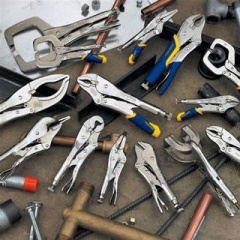Metal Tools
| Infobox on Metal Tools | |
|---|---|
| Example of Metal Tools |  |
| Facts | |
| Origin | - |
| Stowage factor (in m3/t) | - |
| Humidity / moisture | - |
| Ventilation | - |
| Risk factors | See text |
Metal Tools
Description / Application
A tool is any physical item that can be used to achieve a goal, especially if the item is not consumed in the process. Informally the word is also used to describe a procedure or process with a specific purpose. Tool use by humans dates back thousands of years, and other animals are also known to employ simple tools.
Tools that are used in particular fields or activities may have different designations such as "instrument", "utensil", "implement", "machine", or "apparatus". The set of tools needed to achieve a goal is "equipment". The knowledge of constructing, obtaining and using tools is technology.
One can classify tools according to their basic functions:
- Cutting tools, such as the knife, scythe or sickle, are wedge-shaped implements that produce a shearing force along a narrow face. Ideally, the edge of the tool needs to be harder than the material being cut or else the blade will become dulled with repeated use. But even resilient tools will require periodic sharpening, which is the process of removing deformation wear from the edge. Other examples of cutting tools include gouges and drill bits.
- Moving tools move large and tiny items. Most are levers which give the user a mechanical advantage. For example, concentrating-force tools: the hammer moves a nail, the maul moves a stake, or a whip moves flesh on a horse. These operate by applying physical compression to a surface. In the case of the screwdriver, the force is rotational and called torque. Writing implements deliver a fluid to a surface via compression to activate the ink cartridge. Also grabbing and twisting nuts and bolts with pliers, a glove, a wrench, etc. All these tools move items by some kind of force. Also trucks, rockets and airplanes move larger items and particle accelerators move very small items.
- Tools that enact chemical changes, including temperature and ignition, such as lighters and blowtorches.
- Guiding, measuring and perception tools include the ruler, glasses, set square, sensors, straightedge, theodolite, microscope, monitor, clock, phone, printer.
- Shaping tools, such as molds, jigs, trowels.
- Fastening tools, such as welders, rivet guns, nail guns, or glue guns.
- Information and data manipulation tools, such as computers, middleware, IDE, spreadsheets.
Some tools may be combinations of other tools. An alarm-clock is for example a combination of a measuring tool (the clock) and a perception tool (the alarm). This enables the alarm-clock to be a tool that falls outside of all the categories mentioned above.
There is some debate on whether to consider protective gear items as tools, because they do not directly help perform work, just protect the worker like ordinary clothing. They do meet the general definition of tools and in many cases are necessary for the completion of the work. Personal protective equipment includes such items as gloves, safety glasses, ear defenders and biohazard suits.
A Multi-tool is a hand tool that incorporates several tools into a single, portable device; the Swiss army knife represents one of the earliest examples. Other tools have a primary purpose but also incorporate other functionality - for example, lineman's pliers incorporate a gripper and cutter, and are often used as a hammer; and some hand saws incorporate a carpenter's square in the right-angle between the blade's dull edge and the saw's handle. This would also be the category in which the "multi-purpose" tools since they are also multiple tools in one (multi-use and multi-purpose can be used interchangeably). These types of tools were specifically made to catch the eye of many different craftsman who travelled to do their work. To these workers these types of tools were revolutionary because they were one tool or one device that could do several different things. With this new revolution of tools the traveling craftsman would not have to carry so many tools with them to job sites, being that their space would be limited to the vehicle they were driving. The problem of having to deal with so many different tools was solved with the overtaking of multi-use tools.
Shipment / Storage / Risk factors
Corrosion may be caused to metal parts by acidic effect of varnish used on handles, etc., where insufficient time has been allowed for varnish to dry before handles are fitted.
Obviously any wetness may adversely affect the produce in transit.
Rust damage can arise from the nature of the paper used in wrapping or separating articles in cases. Certain papers contain various salts and in one case rusting, at first believed to be due to contact with salt water, was found upon analysis of the wrapping paper to be due to the salts consisting of aluminium, calcium, potassium and sulphates being present in the paper. A test of the paper showed that it burned with some difficulty owing to the presence of these salts.
See also Machinery











